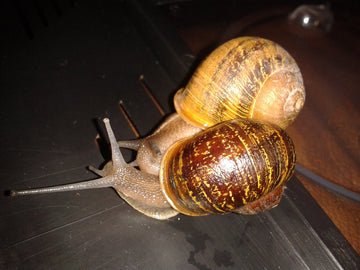What is a fun, interesting way to teach elementary students about heredity and inheritance?
How do I teach the NEXT-GEN SCIENCE STANDARDS about Heredity and Inheritance?
The Next-Gen Science standards say that kids must study heredity and inheritance in first and third grades. We've got a special Children's Animal Book to get kids excited about heredity and inheritance. This year, start with a fascinating and fun story about a snail! Yes, a snail!
JEREMY, THE ENGLISH GARDEN SNAIL: Heredity, Citizen Science and #snaillove ticks so many boxes on your elementary curriculum.
Clear, informative, and quite fascinating. Kirkus Reviews
How does a Children's Animal Book fit into teaching heredity and inheritance to kids?
Page three of the book asks students to look at the snail to find something unusual. Few students will come up with the right answer: the snail’s shell coils to the left.

This is a huge lesson in the importance of observing. Often, we don’t know what is important to observe. One writing exercise would be to stop at page one and ask kids to describe the snail. After a couple minutes, ask them to “see” or “observe” something ELSE. Discuss the importance of even details we don’t think will matter. When they turn the page to discover that the direction a shell coils is important, it should help them to be better at observation.
What do elementary students need to know about Heredity and Inheritance?
The Next-Gen Science Standards expect first graders to know this about heredity and inheritance 1-LS3-1.
Make observations (firsthand or from media) to construct an evidence-based account that
young plants and animals are like, but not exactly like, their parents.
Third graders (3-LS3-2)learn:
Use evidence to support the explanation that traits can be influenced by the environment
In this story of an English garden snail, the first and third grade standards are addressed directly. The basic question of the plot line is this: did Jeremy inherit the left-coiled snail shell from his parents or not.
From the book, first graders can observe the differences in the direction a shell coils. The illustrations show a variety of snails that vary by size, color, and shell orientation.
Third graders will understand that after about 10,000 babies, none of the snail babies had a left-coiled shell. The only other explanation for Jeremy’s shell orientation is an accident of nature. That is, the trait was influenced by the environment.
While reading through the book, stop for discussion of heredity and inheritance on pages 6-7. Which traits came from which parent?

Citizen Science: A Tool for Scientists
Another key component in studying Jeremy was the use of citizen scientist. Because of their anatomy, right-coiled snails only mate with right-coiled snails, while left-coiled snails only mate with left-coiled snails.
Dr. Davison realized that the study heredity and inheritance for this snail, he needed to find Jeremy a mate. Along with his university’s communication department, he launched a “#snaillove campaign. He asked people to look at the snails in their gardens in a new way: did they have a right-or left-coiled shell?
The #snaillove campaign reached an astounding 1.9 billion people worldwide. Initially, they found two left-coiled English garden snails, but eventually they found more than 45. Because the left-coil trait is so rare, a viral campaign is the only way this study could have happened.
The book provides resources on other citizen science projects.

Asymmetrical Anatomy: Study the Human Body
A bonus topic not specifically addressed in the Next-Gen Science Standards is asymmetrical anatomy. In fact, humans are asymmetrical inside, with our hearts on the left side.
I once worked for an ENT doctor and before tonsillectomy surgery, he required all patients to get a chest x-ray. One patient’s x-rays showed that his heart was on the right side, with all the major blood vessels hooked up backwards. This rare condition is called, situs inversus. See this Wikipedia page for a list of Notable Cases of famous people with the condition. (https://en.wikipedia.org/wiki/Situs_inversus)
Introduce your kids to the animal kingdom: Bird. Mammal. Marine Mammal. Spider. Amphibian. Reptile. And gastropod. Learn more about Children's Animal Books book series for elementary students.
Children's Animal Books
For years, we’ve been publishing special animal stories for the Another Extraordinary Animal series. The series includes stories about a single animal, not a species. The animal must be named because of some interaction with humans, and there must be a scientist to interview or adequate scientific information to support the story.
Bird. Mammal. Marine Mammal. Spider. Amphibian. Reptile.
I thought the series was finished. And then along came, Jeremy, the English Garden snail. A Mollusc.
This series includes the story of the oldest bird in the world, a spider in space, an orphaned puma cub, a bullfrog with a world-record leap, the poignant story of saving a tortoise species from extinction, and a fascinating snail.
The series is much more than just an introduction to the animal kingdom. It chronicles the story of how humans interact with animals in various ways: how we enjoy, challenge, admire, endanger, and save them. It's a fabulous series for kids to learn about the amazing complexity of animals.
- Wisdom, the Midway Albatross: Surviving the Japanese Tsunami and Other Disasters for Over 60 Years, Starred Publisher’s Weekly review
- Abayomi, the Brazilian Puma: The True Story of an Orphaned Cub, 2015 NSTA Outstanding Science Trade Book
- Nefertiti, the Spidernaut: The Jumping Spider Who Learned to Hunt in Space, 2017 NSTA Outstanding Science Trade Book
- Rosie the Ribeter: The Celebrated Jumping Frog of Calaveras County
- Diego, the Giant Galapagos Tortoise: Saving a Species from Extinction, Starred Kirkus Review, 2022 Eureka! Nonfiction Honor Book (California Reading Association)
- Pelorus Jack, the New Zealand Porpoise: Inspiring a Government to Protect an Individual Animal
- Jeremy the English Garden Snail: Heredity, Citizen Science and #snaillove
What’s next? I need a fish or shark that meets my requirements of a single named animal with scientific support. If you hear of something, let me know!






1 comment
Another extraordinary post about another exceptional book!